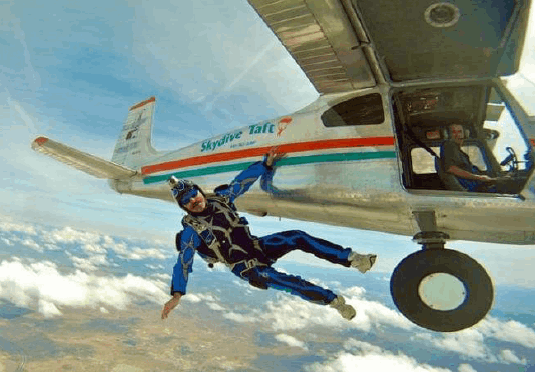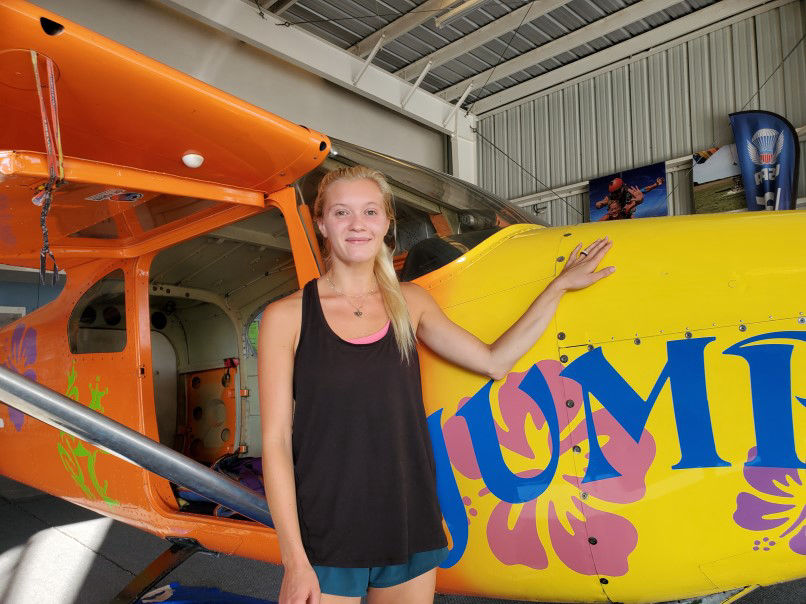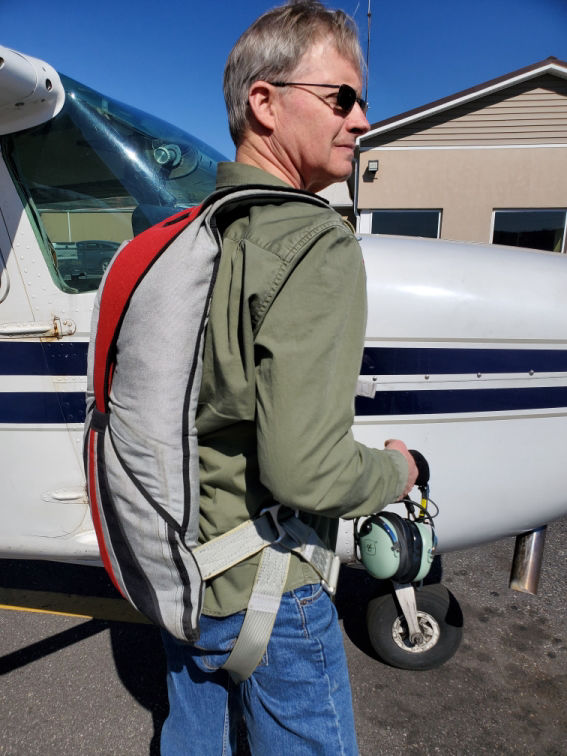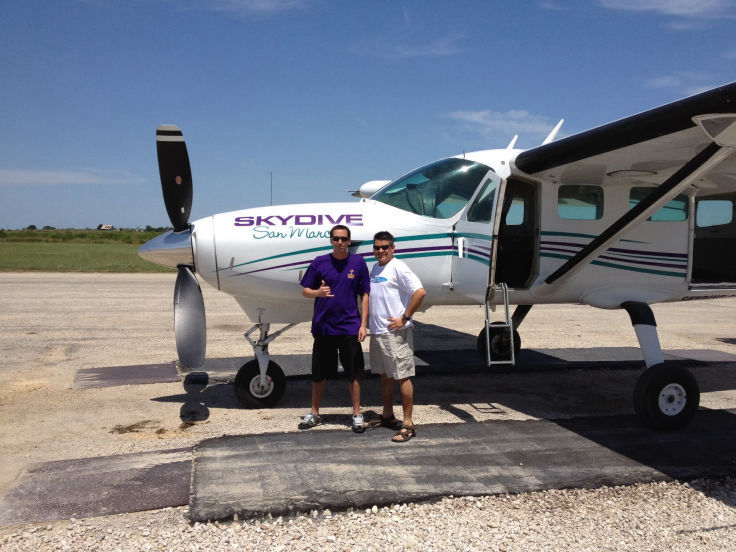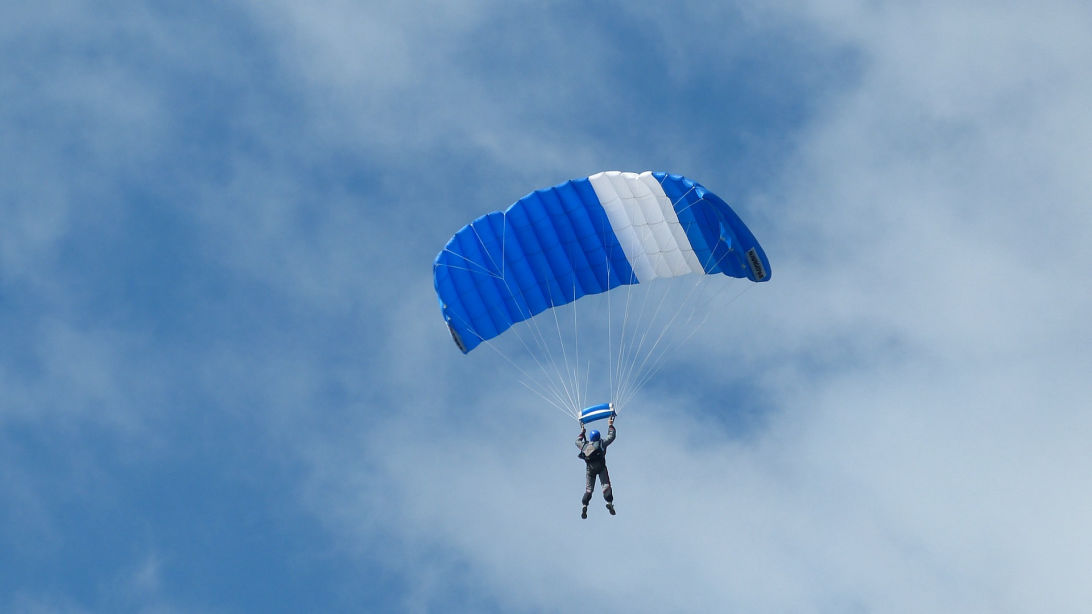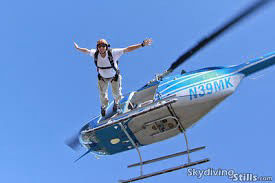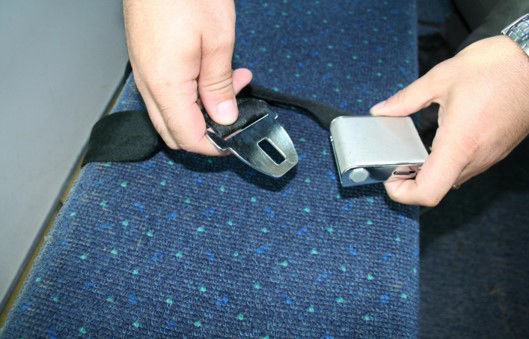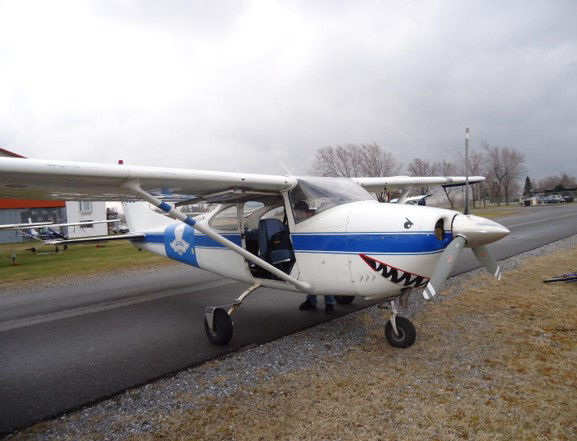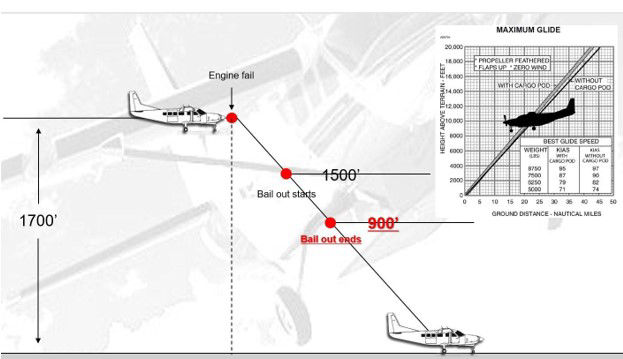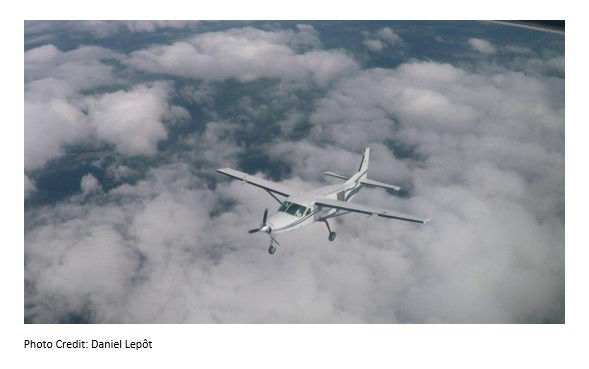He informed me that I was wrong and that I should check out a certain website and how "at this time of year they're hiring Jump Pilots big time!" To which I said, "What is a Jump Pilot?" Again we laughed and he informed me that Jump Pilots fly skydivers up to altitude and kick'em out! I was instantly intrigued.
That very night I checked out the site he mentioned and sure enough, I found drop zones (places where skydiving operations are conducted) all over the country that were hiring! Some of which were ONLY requiring 300TT and a high performance endorsement! I started calling the phone numbers and the first 3 ads that I responded to ALL hired me over the phone!! Not only that, but they were asking me "When can you start?" I was like... ummm... can I call you back?...lol This was all happening SO fast! But then again, I like fast! So after thinking about the pros and cons of each drop zone , I decided to fly for Capitol Skydiving near Austin, TX. Within ONLY one week of Cody telling me what a Jump Pilot was, I was in my car with everything I could fit in it, moving half way across the country! I will never ever forget how excited I felt driving to my first drop zone! You can not put a price tag on that joy.
As I drove through and past the city of Austin, following the directions to the drop zone, I quickly realized that (unlike L.A. where I'm from), after you get 10 minutes out of any city in Texas you can QUICKLY find yourself in cow country! I was like "What the..." I even pulled off the road thinking that I had made a wrong turn or something. I called the DZO (drop zone owner) and told him where I was and he said, "You're on the correct road, just keep going down that road until you see some big red balls on a power line and that's where we are." I was thinking, oh crap, did he just say "balls on a power line"? That's never good. Did they belong to the last pilot?...lol
I drove up, walked in the door and the man said, "You must be Chris?" I said, "Indeed I am and you must be Mike!" Within 10 minutes of small talk greetings he walked me out to the Cessna 206 (with the cargo door removed) and said, "Now show me that you know how to fly this airplane!" I was like (hard swallow), "alright". Now, I MUST explain something first, I had never been in a situation even remotely close to this one. This was a private airport (TE96), with a dirt runway, 2600 feet long by 30 feet wide! With power lines running across the threshold of the runway! Remember? The ones with the big red balls on them?...lol PLUS, I quickly discovered why that airport is called "Crosswinds" airport! Yikes! I was use to flying at Long Beach airport, runway 25L is roughly 5000 feet long by 100 feet wide! No dirt, no power lines! By the way, this is a good point in my story to tell all the younger pilots, during your training, go out and explore small, distant airports! I wish that I had done more of that in my training. Always challenge yourself, never ever get complacent.
So, my new boss Mike asked me to fly him to a local airport and do some touch and goes. To get familiar with the C206 on a hard surfaced runway before landing at his grass strip airport. As we flew to local Taylor airport, I looked down at the ground and realized, yikes, there's not very many landmarks down there! It looked like a giant quilt... farmland. I hope you're starting to understand why flying to unfamiliar airports during your training is so important. I'm flying my new boss in his airplane, thinking, he is going to ask me to fly him back to Crosswinds airport and I don't think that I'm going to be able to even find it! And no, there was no GPS in the airplane at that time. I nailed my touch and goes and then, sure enough, he said "Now take me back to Crosswinds".
Luckily I had noticed 4 large grain elevators kinda near the approach end of the little airport. I was scanning for those sucka's big time! I wanted to show him that I could get us back there without asking him or ATC (he told me not to bother them). I found the grain elevators! To this day, I have never been SO happy to see some grain elevators! They led me to the airport! Now, I had to deal with the dreaded power lines! All Mike said was, "I don't care if we have to go around, just don't flirt with those power lines, I lost one pilot to those already". Yeah, that wasn't distracting or anything...lol It sure wasn't funny at the time, but it is now.
So, I am happy to say I nailed 3 touch and goes there as well! I parked the airplane and tied it down. He said, "I'm very happy with your flying", "I want this airplane pre-flighted by 8am, you'll have your first load of skydivers at 9am." and walked back into the office. I'll never forget that shock! The words that came out of my mouth to him were, "Sounds good!". But inside I was like... wait... what about... what the... did he just say? Again, this is hilarious now, but at the time it was straight craziness!
Needless to say, I didn't sleep much that night and not just because I was in a completely new environment. I remember thinking, "Am I really gonna drop people out of that airplane tomorrow?", "Like really?", "Are the skydivers going to be nervous that a rookie is flying tomorrow?" By the way, the answer to that question is... hell yes!...lol Most skydivers are sketchy of new pilots. Yes they do make them nervous, which is completely understandable. Most TI's (tandem instructors) and Videographers have spent many more hours in airplanes than rookie Jump Pilots and they will watch your EVERY move. But it's smart of them to do and I'm glad they do it. They tend to sit a little bit closer to the door when a newbie pilot is flying. If you're a good pilot and you have a good personality you will be welcomed into that drop zone family fairly quickly, and it truly is a family too! We all work together... I mean "fly" together, look out for each other, go out to dinner together and play together. You TRULY get to know each other. Some of them will be lifelong friends of yours.
Requirements
Most of the Jump Pilot hiring is done in the months of March and April. You will find a few drop zones that will hire you with a minimum of a Commercial Certificate, 2nd Class Medical and 300TT. That number, by the way, is a bare minimum and most drop zones require at least 500TT due to their insurance policies. They will also have a pilot on hand to train you how to fly skydivers. For more information on training check out my Training Page.
Not all pilots will cut it. Through out the years I have had to let a few pilots go that simply could not get it. I even remember one of them that was too freaked out that we have to open the door during flight. Um... yeah... we HAVE to open the door or they can't jump out silly...lol NEXT!
There are a few drop zones that will hire you into a Caravan or PAC 750 if you have at least 1,000 TT plus 25 hours in type, and jump pilot experience, again per their insurance requirements. I love the Caravan and have created a site to help Caravan Pilots, Mechanics and Owners, you can find it here. The Caravan is the most popular turbine jump airplane worldwide. Check out my Skydive Aircraft list here for more information about all of the various jumpships!
Pay and Perks
You will fly approximately 100 hours per month. The amount of hours flown per month varies depending on what month it is (June-August is peak), whether you are the main pilot or a back-up, if your drop zone is newer or older and established. Weather will obviously also play a role. A Cessna 182 (the most popular jump plane worldwide) can do 2.5 loads per flight hour up to 11,000ft MSL. If you are flying less loads than that per flight hour you are doing something wrong. By the way, my record amount of loads in a C182 is 23 loads in one day! Crazy huh? At $15/load, not a bad payday.
During the off peak season you will be flying less than half of what you were during the Summer. So I highly recommend that you have some supplemental income coming in. Most northern drop zones are closed Oct - March. Drop zones in northern states that have larger aircraft ie. Caravans, PAC 750s or Twin Otters lease those to southern drop zones that only have 182s or 206s. When the larger aircraft are leased to other companies, the leasing company usually provides the pilot not the leasee. I've worked for companies on either end of the spectrum. And that is another huge perk to this job, if you happen to be flying a smaller jump plane at a drop zone that decides to lease a larger one, you can get your hands on that larger aircraft at zero cost to you! Before I was hired to fly them, I had flown many Caravans and Twin Otters from the right seat during skydiving operations. The pilot's will usually instruct you while you fly it. Side note: It would be in your best interest to buy that pilot a "beverage" or two at the end of the day. That is, only if you would like to sit right seat again.
Challenges
Flying skydivers is very challenging and weight and balance is one of the most challenging parts of it. You should already know not to take-off with an airplane that is heavier than it's Max. Take-Off weight limit. For a C182 I believe that it's 2950lbs. Plus you have the whole weight shift during flight issue, when they move from a seated position to an exit position. In a Cessna 182, you will often have 2 skydivers hanging from the right wing strut plus 2 more hanging out of the doorway. Talk about parasite drag! When they are hanging on the strut and in the doorway, the control wheel is fully to the left and opposite rudder. You MUST watch your airspeed! Skydivers have been killed because the pilot stalled the airplane with skydivers in the doorway. They lose their grip on the wing strut and end up getting struck by the bottom of the wing or the leading edge of the horizontal stabilizer.
After they drop away, its neutral control wheel and full left rudder to get the door to drop down enough for me to grab and latch it. Tell ATC, "Jumpers away", close the cowl flaps and then I would put the airplane in a left bank, keeping an eye on the divers the ENTIRE time and then I put it into a slip. Alternating between right and left slips. This can be accomplished without over stressing the airplane. We slip the airplane to descend faster and to avoid shock cooling. There have been debates in my Jump Pilot group on whether or not we should slip the airplane on the way down. I can tell you that I've flown over 6,500 loads of skydivers and it worked great with zero problems. But if the DZO doesn't want you to slip it, then don't do it. You do not own that airplane and you should respect their property.
I keep the airspeed within the yellow arc. The VSI is pegged, but I'm guessing around 3,000 fpm. It is very important to keep your eye on the skydivers the entire time, while scanning for other traffic. Also, don't forget to tell ATC: "Jumpers on the ground", they usually appreciate that. Do them favors whenever you can, they help us every single day and I believe that most pilots take them for granted.
Whenever I've been hired at a new DZ, I have always arranged a meeting with the local ATC facility. I feel that it is important to personally meet the people that protect us everyday, thank them and shake their hand. It is also important to ask them what we as Jump Pilots can do to make their jobs easier. Maybe I have an "old school" approach but I believe that it's a school that's respectable and always appreciated by the Controllers that I meet.
I must add the fact that I love the positive energy at drop zones! Everybody is having fun and most skydivers are passionate about what they do as I am about flying them! According to my log book, I have flown over 6,500 loads of skydivers and I have smiled EVERY single time they have jumped out! After more than 6 years of flying skydivers, I still think... dude, those people just jumped out of your airplane! As I hear their screams fall away...lol How can you not smile about that? I hope this article helps a few young birds decide if they want to become a jump pilot! It's definitely not for everyone. It's only for cool pilots!
~Blue Skies, Christopher Rosenfelt
If you have any questions about this or any of my other articles, feel free to email me anytime at chris@caravannation.com
